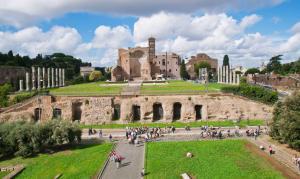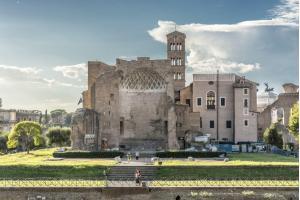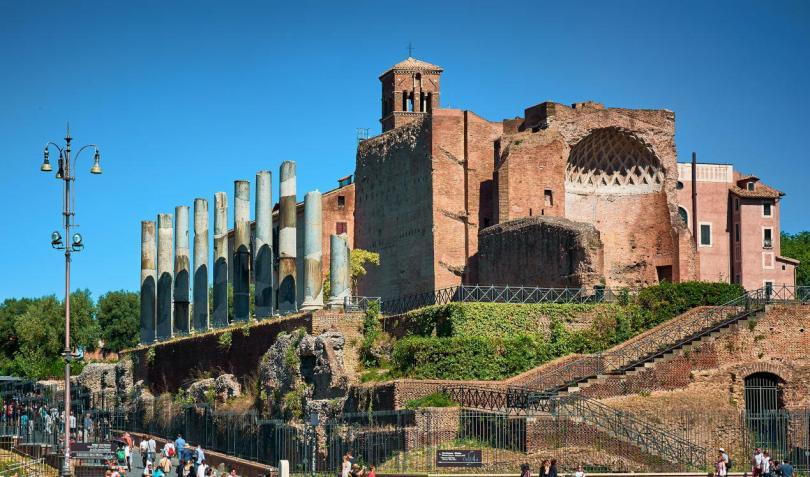On the imposing artificial base that still appears on the west side of the valley of the Colosseum are the remains of the largest temple Rome ever had: Temple of Venus and Roma. The temple dedicated to the Eternal City and to the goddess Venus, the mother of Aeneas, the founder of the city. Temple of Venus and Roma, set in between the Basilica of Maxentius and the Colosseum, bases on a substantial synthetic platform on bases which bigger the hill of Velia.

Temple of Venus and Roma – Corinthian Columns Roman Forum Rome Italy. Largest temple in ancient Rome, dedicated in 141 AD by Emperor Hadrian
Begun in A.D. 121 and inaugurated in 135 A.D, the Temple of Venus and Roma was created by Hadrian himself, a“great” emperor, passionately keen on art and architecture. The structure was set within a confining double pillars which left the 2 primary exteriors free and which had 2 entryway propylaea at the center of the long sides. The measurements (m. 145-100) of the whole ensemble are enforcing.
The temple was built on a site previously occupied by the vestibule of the Domus Aurea, retaining its orientation and partly reusing its foundations. Before it could be built workmen had to move the colossal statue of Nero, the biggest bronze statue ever made in the ancient world (at least 35 metres high Pliny says).
Temple of Venus and Roma, the largest temple in Ancient Rome, Reconstruction by Atavistic #roman #architecture pic.twitter.com/tguxFZ1xaW
— Gareth Harney (@OptimoPrincipi) 18 Aralık 2015

Temple of Venus and Roma at the Roman Forum in Rome, Italy. Roman Forum is one of the main travel attractions of Rome. Ancient architecture and landscape of central Rome.

The most important temple in Rome was designed by Hadrian. Begun in 121 AD, construction was interrupted by the emperor’s death and it was finally completed by his successor Antoninus Pius.
Temple of Venus and Roma itself was a big Corinthian decastyle (with 10 columns on the front and nineteen on the sides) structure. It did not have the traditional podium of Roman temples however based on a stylobate with 4 actions and included 2 cellae which were held up to back. Entryway to the celiae was through 2 patios with 4 columns in between the antae.

View of the Colosseum from the Sacra street. In the image you can also see the columns of the temple of Venus and Roma.
Initially neither cella was apsed and they were covered with flat wood roofings. Their present element is the result of restoration effected by Maxentius in A.D. 307, after a fire. The building acquired its present form, with apses and barrel vaulting, when it was restored by Maxentius in A.D. 307. The cellae were provided apses at the back which included the cult statues of Venus (in the cella facing the Colosseum) and of the goddess Roma (facing the Forum) while coffered and stuccoed barrel vaults changed the initial ceiling. In addition, the long sides were lined with porphyry columns. Specific niches indicated for statues were framed by little porphyry columns on brackets. The pavement was likewise restored in polychrome marble.

Temple of Venus and Roma in the Roman Forum. View from Colosseum. It was dedicated to the tutelary goddess of the city, Roma, and to Venus as patron of the imperial house.
The cella of the goddess Roma, facing the Forum, is the much better protected of the 2. It is now part of the exconvent of S. Francesca Romana, and the peristasis has actually been changed by a hedge. Just a couple of the grey granite columns of the portico are still standing.
In its rejection of the stylistic aspects of Roman temple architecture and in turning for motivation to the Greek world which the emperor busily appreciated, this temple, which is among the biggest ever integrated in Rome, is a best example of the classicism which defines Hadrian’s art. The significance of this diversion far from the preceding custom ends up being even more obvious in factor to consider of that Apollodorus of Damascus, the designer of Trajan’s enforcing works, made a criticism of the temple on esthetic premises and so he was punished with exile.
Distance to the Colosseum
Venus and Roma, 0,35 km from (4 min walk) from Colosseum.





Leave a Comment